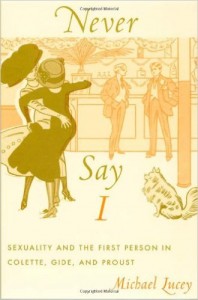 Never Say I: Sexuality and the First Person in Colette, Gide, and Proust
Never Say I: Sexuality and the First Person in Colette, Gide, and Proust
by Michael Lucey
Duke University Press. 321 pages, $23.95 (paper)
IN VOLUME I of The History of Sexuality, Michel Foucault argued that the second half of the 19th century witnessed a major shift in the way that the West defined persons who were sexually attracted to members of their own sex. Until then, the West had thought that anyone might at times be subject to such deviations from the norm, Foucault argued; but this did not specify a type of person with a fixed sexual identity. With the advent of the new “science” of sexuality, however, the homosexual emerged as a distinct “species,” to use Foucault’s provocative word. Most of what passed for medical research and legal analysis ended up portraying these new “homosexuals” in a decidedly hostile and derogatory light. This view in turn engendered responses from certain intellectuals who found themselves on the receiving end of these new explanations and diagnoses.
Nowhere were these responses more in evidence than in France, if only because France was the only major Western nation at the time where homosexual acts were not illegal and could be discussed positively in print without prosecution. Granted, even France had laws against “assaults on public decency,” so one couldn’t get too specific about certain things. Still, homosexuals there could write about their desires and live somewhat openly, a luxury that did not exist in England, Germany, the U.S., and so on.
In his latest book, Michael Lucey, who has already written about same-sex issues in Balzac and Gide, examines very carefully how three French citizens involved with same-sex desire—Colette, Gide, and Proust—took advantage of the newness and fluidity of the concept of homosexuality to advance his or her own unique viewpoint over competing ones. The first thing each author had to do was to become established as a serious writer and thinker; then they had to assert their authority to speak on this particular subject without, in the process, losing the respect of the audience they were addressing. This task was particularly complicated for Colette, who was also developing a career as a sometimes avant-garde stage performer, still a profession regarded as morally suspect by certain parts of society, and whose non-traditional personal life was most on view in the general press. It was not easy for Gide or Proust either, however, as they both wanted to express in their works what each saw as the truth about same-sex desire without losing the respect of their various publics. Gide, for example, argued that the only respectable form of male homosexuality was pederasty; he grouped men attracted to other adult men together with inverts and effeminates as “abnormal.” The three ended up developing different ways of speaking about homosexuality and their relationship to it for different contexts.
The most rewarding sections of this book in this respect are those dealing with Colette, who had the most public life of the three. Living in an era when illustrated magazines devoted at least in part to celebrities were enjoying a great success—the beginning of what the French now call “la presse people”—she very much played with them, as did her contemporary Pierre Loti, in both cases to fashion an image that had a very strong visual component and to keep others, such as gossip columnists and the forerunners of our political pundits, from fashioning an image for her. As Lucey shows, Colette ended up creating not one but several public personae, what he calls “a field of first-person voices,” which allowed her to maintain control over the image that she projected as the need arose.
Indeed, this book might more accurately have been titled “Often Say I,” since Lucey spends much of it showing how all three of these authors made particular and careful use of the first-person pronoun, with its implications of sincere self-revelation, to shape their readers’ conceptions of themselves and those for whom they claimed the authority to speak. (Lucey’s title comes from a remark that Proust may have made to Gide.)
The introduction, which contains the obligatory review of all related theoretical works, is slow reading and can be skipped with no loss of comprehension of the rest of the book. The epilogue, on the other hand, which ties everything together, is particularly fascinating. Since same-sex-attracted men and women still argue about how to define themselves and others today, it is all that much more interesting to see how three particularly masterful users of language went about doing so when the field was new and virtually wide open.
____________________________________________________________________
Richard M. Berrong is the author of In Love with a Handsome Sailor.





